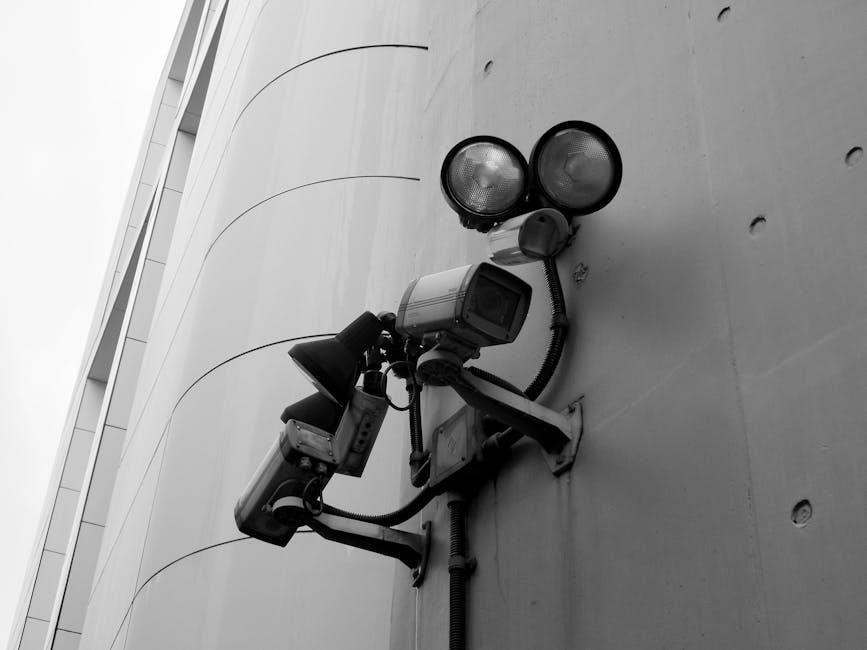Manual fire detection systems provide early fire detection through human intervention. These systems include manual pull stations that‚ when activated‚ trigger alarms to alert occupants. They are essential for safety in various settings‚ ensuring timely evacuation and response.
Overview of Manual Fire Detection Systems
Manual fire detection systems rely on human intervention to identify and report fires. These systems typically include components like manual pull stations‚ control panels‚ and alarm devices. They are designed to integrate with automatic detection systems‚ ensuring comprehensive fire safety. By providing a straightforward method for occupants to alert others‚ manual systems play a critical role in early fire detection and response‚ complementing automated solutions to enhance overall safety and compliance with fire safety standards.
Importance of Manual Fire Detection in Safety
Manual fire detection systems are crucial for ensuring early fire identification and response. They provide a reliable means for occupants to alert others‚ especially in areas where automated systems may not detect fires quickly. These systems enhance safety by offering a direct method for human intervention‚ ensuring timely evacuation and emergency response. Their importance lies in their simplicity and effectiveness‚ making them a vital component of fire safety strategies and compliance with safety regulations.

Key Components of Manual Fire Detection Systems
Manual fire detection systems consist of essential components like manual pull stations‚ control panels‚ and alarm devices. These elements work together to ensure effective fire detection and response.
Manual Pull Stations
Manual pull stations are critical components of fire detection systems‚ enabling individuals to trigger alarms in emergency situations. Typically installed in accessible locations such as hallways or near exits‚ these stations are designed for easy activation. When pulled‚ they signal the control panel to activate alarms‚ alerting occupants and facilitating evacuation. Their visibility and strategic placement ensure quick response‚ making them indispensable for fire safety in commercial and residential settings. Proper installation and maintenance are vital to ensure reliability and compliance with safety standards.
Control Panels and Their Functions
Control panels are the central hub of manual fire detection systems‚ monitoring and managing all connected devices. They process signals from pull stations and detectors‚ detecting potential issues. These panels coordinate alarm responses‚ ensuring timely alerts. Advanced models support multiple zones‚ tracking specific locations of activations. They also store event logs for later analysis‚ enhancing system reliability and compliance with safety regulations. Their role is crucial for effective fire safety management and emergency response coordination.
Alarm Devices (Horns‚ Strobes‚ etc.)
Alarm devices such as horns and strobes are critical for alerting occupants during a fire emergency. Horns produce loud‚ audible signals to ensure everyone hears the alarm. Strobes emit bright‚ flashing lights to visually signal danger‚ especially in noisy environments or for those with hearing impairments. These devices are strategically placed throughout buildings to maximize visibility and audibility. They are often integrated with control panels to ensure synchronized activation‚ providing clear and effective warnings to facilitate safe evacuation and emergency response.

How Manual Fire Detection Systems Work
Manual fire detection systems operate through user activation. Pull stations trigger alarms‚ alerting occupants to evacuate. The system ensures timely response and safety through clear‚ audible‚ and visual signals.
Activation Process of Manual Pull Stations
Manual pull stations are wall-mounted devices that activate fire alarms when pulled. Users pull a lever or break glass to trigger the alarm. Once activated‚ the system sends signals to the control panel‚ initiating audible and visual alerts. This immediate response ensures timely evacuation and emergency services notification‚ crucial for fire safety in buildings.
Signal Transmission to the Control Panel
When a manual pull station is activated‚ it sends an electrical signal through wired or wireless connections to the fire alarm control panel. The control panel processes this signal‚ identifying the zone or location of the activation. It then triggers alarms and notifications‚ ensuring a rapid response to potential fires. This reliable transmission is critical for maintaining fire safety and enabling timely emergency actions.
Triggering Alarms and Notification Systems
Upon receiving a signal from a manual pull station‚ the control panel activates alarms and notification systems. These include audible devices like horns and visible alerts such as strobe lights. The system ensures rapid notification of occupants‚ enabling timely evacuation. Integration with emergency lighting and sprinkler systems enhances safety by providing a comprehensive response to fire incidents. This swift activation is crucial for minimizing risks and ensuring effective emergency management.

Installation and Placement Guidelines
Manual fire detection systems must be installed in compliance with fire safety standards. Proper placement ensures accessibility and visibility‚ while certified professionals handle the installation process.
Recommended Locations for Manual Pull Stations
Manual pull stations should be installed in visible‚ accessible locations near exits‚ stairways‚ and corridors. They are typically placed at a height of 3.5 to 5 feet for easy reach. Strategic placement ensures quick activation during emergencies‚ while clear visibility prevents tampering. Installations must comply with local fire codes and standards‚ ensuring proper coverage and accessibility for all occupants. This placement maximizes effectiveness in initiating timely alarms and facilitating safe evacuations.
Fire Alarm Control Panel Installation Requirements
Fire alarm control panels must be installed in central‚ accessible locations‚ such as main entrances or security rooms. They should be securely mounted and protected from vibration. Power supplies must be reliable‚ with backup options like batteries. Panels should be connected to all system components‚ ensuring proper communication. Regular testing and programming are essential to maintain functionality. Compliance with local fire safety standards and codes is mandatory to guarantee system performance and reliability in emergencies.
Ensuring Compliance with Fire Safety Standards
Compliance with fire safety standards ensures manual fire detection systems operate effectively. Regular inspections and testing of pull stations‚ alarms‚ and control panels are required. Systems must adhere to local fire codes and regulations‚ such as NFPA standards. Proper documentation of inspections and maintenance is essential for compliance. Training staff on system operation and emergency procedures is also critical to meet safety requirements and ensure reliable performance during emergencies.
Maintenance and Inspection
Regular maintenance and inspection of manual fire detection systems are crucial for ensuring reliability. This includes testing components‚ checking for damage‚ and verifying proper function to meet safety standards.
Regular Inspection Checklists
Regular inspections ensure manual fire detection systems function properly. Checklists include verifying pull stations‚ wiring‚ and control panels for damage or tampering. Test alarm devices to ensure they activate correctly. Inspect all components for proper installation and functionality. Clean detectors and ensure no obstructions block signals. Document all findings and address issues promptly to maintain system reliability and compliance with safety standards. Consistent inspections prevent malfunctions and ensure timely response in emergencies‚ safeguarding lives and property effectively.
Testing Procedures for Manual Systems
Testing manual fire detection systems involves activating pull stations to ensure alarms trigger correctly. Control panels should be checked for proper signal reception and response. Alarm devices must be tested for functionality and adequate volume. Regular testing‚ such as monthly or quarterly‚ is crucial to verify system reliability. Authorized personnel should conduct these tests‚ ensuring the system resets properly afterward. Documentation of test results is essential to identify and address any issues promptly‚ maintaining system effectiveness and compliance with safety standards.
Addressing Common Maintenance Issues
Common maintenance issues in manual fire detection systems include worn-out pull stations‚ faulty wiring‚ and malfunctioning alarm devices. Regular inspections help identify these problems early. Technicians should test components and replace damaged parts promptly. Cleaning devices ensures proper function‚ while tightening connections prevents signal loss. Addressing these issues ensures system reliability and compliance with safety standards‚ maintaining a safe environment through consistent upkeep and attention to detail.
Troubleshooting Common Malfunctions
Identify false alarms by inspecting pull stations and wiring for damage. Test alarm devices and connections to ensure proper function‚ resolving issues promptly to maintain system reliability.
Identifying False Alarms and Their Causes
False alarms in manual fire detection systems often result from accidental activation of pull stations or system malfunctions. Environmental factors like dust or humidity can also trigger sensors. Regular inspection of wiring and devices helps pinpoint causes. Testing alarm devices ensures they function correctly. Addressing these issues promptly prevents unnecessary disruptions and maintains trust in the system. Proper maintenance and user training are key to minimizing false alarms and ensuring reliable fire safety.
Resolving Connectivity Issues
Connectivity issues in manual fire detection systems often arise from wiring problems or faulty connections. Regularly inspecting wires and connections can help identify and resolve these issues. Testing communication between devices ensures proper functionality. Ensuring all components are securely connected and free from damage is crucial. Addressing these problems promptly maintains system reliability and ensures timely alerts during emergencies. Proper installation and adherence to manufacturer guidelines also help prevent connectivity-related malfunctions.
Repairing Damaged Pull Stations or Wiring
Damaged pull stations or wiring must be repaired promptly to ensure system functionality. Inspect wiring for breaks or corrosion and replace damaged sections. Pull stations should be tested post-repair to confirm proper operation. Ensure all connections are secure and meet fire safety standards. Regular maintenance can prevent future issues. Always follow manufacturer guidelines during repairs to guarantee system reliability and compliance with fire safety regulations.

Advanced Features and Integration
Modern systems integrate with building management systems‚ enabling smart alarms and remote monitoring. This enhances response efficiency and ensures seamless communication across all safety platforms.
Combining Manual and Automatic Detection Systems
Combining manual and automatic fire detection systems enhances safety by leveraging both human intervention and automated sensors. Manual pull stations ensure immediate alerts‚ while automatic systems detect smoke or heat. This hybrid approach provides comprehensive coverage‚ reducing response times and false alarms. Integration ensures seamless communication between components‚ optimizing reliability. Advanced systems can even pinpoint fire locations‚ streamlining evacuation and firefighting efforts. This combination is ideal for large facilities‚ offering robust protection and adaptability to varying fire risks.
Integration with Building Management Systems
Integrating manual fire detection systems with building management systems (BMS) enhances overall safety and operational efficiency. This integration allows real-time monitoring of fire detection data alongside other building systems‚ such as HVAC and security. Automated responses can be triggered‚ ensuring faster incident management. Centralized control enables seamless coordination between fire detection and other safety mechanisms‚ improving emergency response times and reducing risks. This advanced integration ensures comprehensive safety management and enhances situational awareness for building operators.
Smart Alarms and Remote Monitoring
Smart alarms and remote monitoring enhance manual fire detection systems by enabling real-time alerts and remote oversight. Advanced systems can be integrated with smartphones or monitoring stations‚ allowing immediate response to emergencies. Remote monitoring ensures continuous supervision‚ reducing response delays. Smart alarms can also identify the exact location of the activation‚ aiding in quicker incident resolution. This technology improves safety by ensuring timely interventions and minimizing potential damages‚ making it a crucial advancement in fire safety management.
